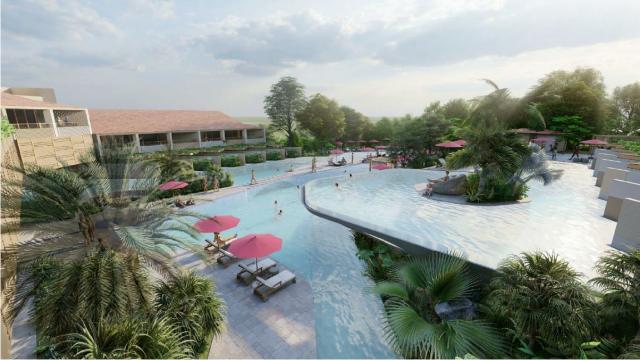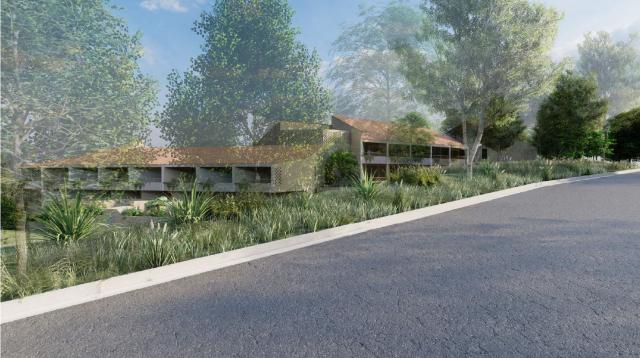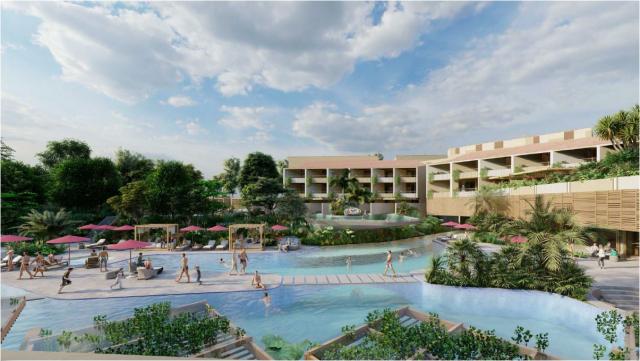The potential odour emanating from a Unitywater sewerage treatment plant and possible costs of their control were raised as major concerns impacting a proposed five-star hotel development to be located only 200m from the plant.
Noosa Council discussion on the development application for a five-star boutique hotel at Noosa Springs was halted at Tuesday’s Planning and Environment Meeting after three separate deputations were delivered on the proposal.
The application, an initiative of GH Australia, the Australian arm of Hong Kong property and development firm, Golden Horse Group and owner of Noosa Springs Golf and Spa Resort, proposes the construction of a $50 million 106-room hotel spanning five two and three stored buildings and featuring a two-level lagoon style swimming pool.
Deputations were put forward by architect John Cochrane opposing the development, Unitywater’s Rhett Duncan who warned of the odour impact from the nearby sewerage treatment plant (STP) and urged council not to approve the development application and the developers representative Ellen Guan.
Rhett Duncan of Unitywater, the water and wastewater service provider for the Noosa region, told the meeting, “we do not support this development in its proposed location. It is too close to the existing Noosa sewerage treatment plant,” he said.
Mr Duncan said sewerage treatment had been carried out at the plant since the mid-1970s, the plant upgraded in 1997, and operations transferred to Unitywater in 2010, under Department of Environment and Science (DES) approval.
Mr Duncan said the original Noosa Springs development was shielded from STP odours by a 400m odour buffer that included geographical ridges.
“When the Noosa Springs development was proposed Council made a conscious plan to shift the plan a further 300m to the south away from the sewerage plant’s sensitive receptors,” he said. “The 1997 STP was designed with consideration to this 400m buffer to the then proposed Noosa Springs development.”
“This (hotel) development is 200m from the STP. It encroaches up the ridge line.
“Approving this development is not only in conflict with council’s own earlier decisions to minimise potential impact of the STP on nearby land uses but in conflict with the intent of state planning policy.”
Mr Duncan said there had been few complaints about odour and Unitywater had operated its plant to minimise odour but there were limits to what they could do, particularly if there were unintended or unavoidable odour release events such as a sewerage network asset breakdown, significant rainfall or heatwaves.
Mr Duncan said Unitywater noted the developer’s intention and Council conditions to manage the odour internally through measures including an odour complaint management plan, the maintaining of an odour complaints record, notifying guests of potential odours, full air-conditioning and restricting the times of outside use of facilities.
He said responsibility of the odour could not be transferred.
“DES does not take this into account when investigating complaints. Odour complaints made to the regulator will be investigated and could result in action against Unitywater that may lead to prosecution and costly plant modifications,” he said.
In 2010 Unitywater installed odour control equipment at Murumba Downs, the cost was $38 million, he said.
He said any risks to Unitywater and its customers could be avoided if the development was not approved.
“We couldn’t help wondering, if the reverse situation occurred, would a new STP be approved 200m from a luxury resort,” he put to council.
Architect and Noosa Springs resident John Cochrane said he represented some of the 450 residents who made submissions against the proposal, 1500 residents who will be negatively affected by the proposal and the Noosa wide cohort who will potentially be affected by the likely need for upgrade of a nearby sewerage plant upgrade and consequent charges.
Mr Cochrane identified a range of core planning concerns of the proposal in addition to odour concerns including 65 per cent of the development’s floor space being built on land zoned Open Space / Recreation, the impacts on existing infrastructure from noise, traffic congestion and the exacerbation of an existing risk from bushfire, making evacuation more problematic.
He said the proposal was inconsistent with the outcomes of Noosa Plan 2020 as it does not meet community or recreation needs.
Mr Cochrane said the only rationale presented for setting aside the land zoning under the Noosa Plan 2020 was that there were no other sites available and the hotel function can not be located on the existing Tourist Accommodation zoning.
Mr Cochrane said the proposal failed to address potential conflict between permanent residential usage and short term holiday letting.
It has major noise sources including a two level resort pool, service areas and bus access and a function area large enough to accommodate 500 guests, he said.
There is no assessment of the impact of amplified music which will be used in the pool area. There will be significant noise generated by functions – particularly weddings and parties. The noise impacts will be felt by a broad range of existing users, he said.
“We believe that a smaller scale hotel can be built on the site,” he said. “This would be a true boutique offering of high economic value. The focus would be on low scale development with limited shared facilities – this will encourage use of the existing Noosa Springs Resort facilities.”
Mr Cochrane said such a model was widely used in the ecotourism market, appropriate to the Noosa Springs environment and the strategic objectives of the Noosa Plan.
GH respresentative Ellen Guan said their intention was to create the best version of Noosa Springs. Community and wellness are the key words that define the development, she said.
Ms Guan spoke about the job and career opportunities the hotel would provide in the area, the developers focus on sustainability and their aim for the hotel to be a setting for connections between the local community and guests.
In response to the deputations Ms Guan said GH had been in discussions with Unitywater.
“Noosa Springs been operating for almost 25 years. Odour has never been an issue. The hotel will not worsen the risk to Unitywater,” she said.
“GH and council have used specialists consultants in this field and both support the development subject to conditions.
“The proposed hotel development will not put Unitywater in a worse position. The possibility of a perceived incident in the future is extremely low.”
In response to concerns the hotel will add traffic to the road in the event of an approaching bushfire she said their bushfire consultants emergency plan requires guests to remain onsite at an assembly point and guests would not use the external road.
Ms Guan said since 2016 at their first meeting with council GH had made many changes to the hotel design, respecting and valuing input from responders and the community.
Council officers recommended the development application be approved subject to conditions, providing the following reasons for their decision.
“The application seeks to develop a of 106 room 5-star hotel on land within the existing Noosa Springs development. The site is split zoned, with both the Tourist Accommodation Zone and the Recreation and Open Space Zone affecting the site. The split zoning at the time sought to recognise the need for a buffer distance (to mitigate potential odour impacts) associated with the nearby sewage treatment plant (STP). Supporting documentation has assessed the odour impacts of the STP to determine the appropriate building footprint and associated outdoor recreation areas. This material has been reviewed and supported by Council’s consulting odour expert with conditions recommended to address use of outdoor areas and ventilation of the building at its interface with the accepted odour limit.
“The proposed built form is consistent with the prevailing built form within Noosa Springs and compliments the golf clubhouse and spa facilities which are located nearby. The building does exceed the height limit due to the topography of the site and the large footprint anticipated in buildings providing resort accommodation. Site cover does not exceed the combined amounts permitted for both the Tourist Accommodation Zone and the Recreation and Open Space Zone whilst the plot ratio complies with the requirements of the Tourist Accommodation Zone. The application has also demonstrated compliance with the carparking, bushfire, and water quality/quantity requirements of the Noosa Plan whilst variations to setbacks associated with the two-level car park and elevated tennis courts are supported.”
The development application was referred to Council’s General Meeting next Monday for consideration by all councillors.









